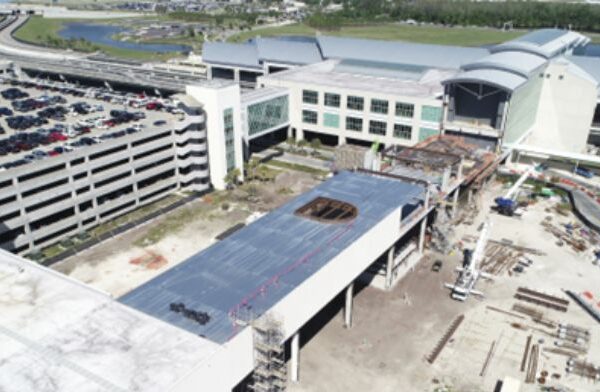There has been a paradigm shift in airports’ approach to terminal design in recent years. With an increasing focus on prioritising passenger wellbeing, Chloë Greenbank reports on some of the latest trends that go beyond the functional aspects of efficiency and convenience.
While for some the airport journey heralds the start of an adventure, an exciting meeting point for connecting with family or friends or simply a place to catch up on emails ahead of a flight, for many it can be a stressful and demanding experience. So how are stakeholders now turning their attention to elements and features that will enhance the overall comfort, relaxation and satisfaction of travellers when designing terminals?
“Travelling can be inherently stressful for many guests, with long wait times, crowded spaces and a lack of amenities exacerbating that stress,” admits Rick Blatstein, CEO of OTG.
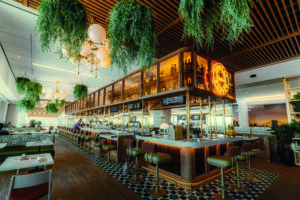


The three pillars: OTG’s concept is based on design, dining and technology.
He explains that OTG is on a mission to revitalise the passenger-terminal relationship by integrating next-level technology with carefully curated food and retail options and striking redesigns of the terminal space.
“Through our three pillars of design, dining and technology, we aim to reduce the hassle and anxiety associated with the airport experience,” says Blatstein. “We work closely with port authority partners to ensure that our offerings align with their passengers’ needs and preferences.”
OTG developed its proprietary flo Xgen technology to reduce wait times and enhance convenience by enabling guests to order directly from their personal devices.
“One of the most notable changes we’ve seen in terms of passenger behaviour over the last couple of years has been the desire for passengers to use their own personal devices, over public ones.
“By developing our flo Xgen mobile platform, we are leveraging cutting-edge technology to give the customer full control and provide a seamless, personalised experience for all travellers who visit our dining concepts.”
The company also places strong emphasis on sustainability and locally sourced ingredients, working with local vendors and farmers to provide fresh, healthy, eco-friendly dining options.
“Our customer-first approach also extends to the design and layout of our airport spaces, which offer comfortable, inviting and elevated environments in which travellers can relax and linger, without feeling captive in an airport,” says Blatstein.
Wellness in a virtual world
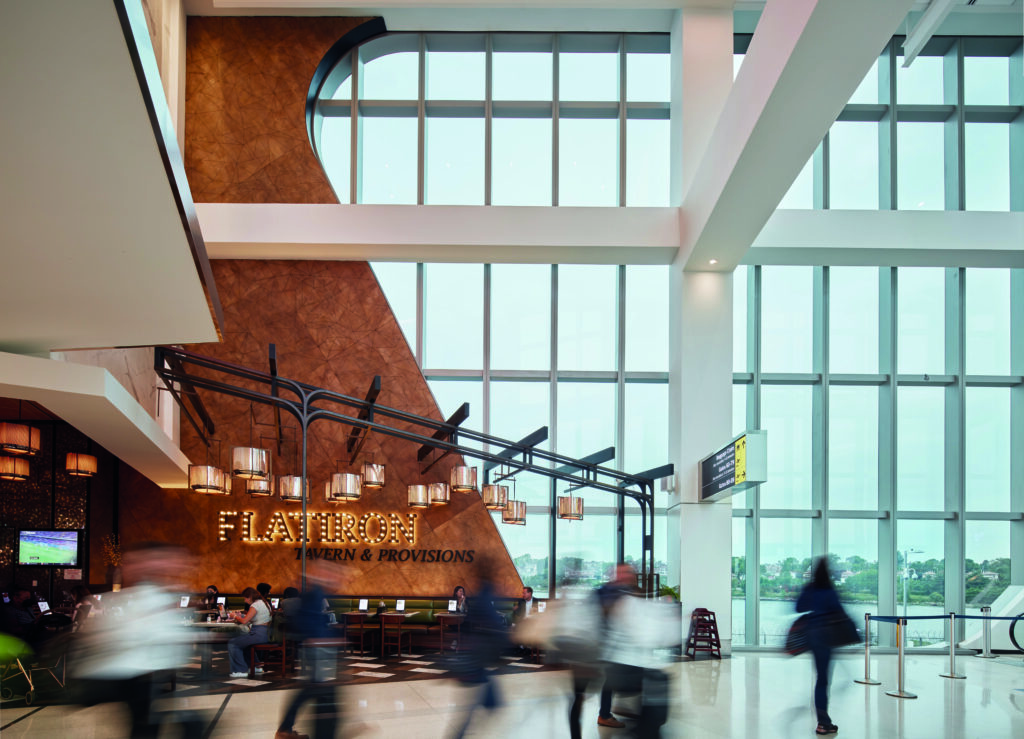


The lighter side of life: Corgan incorporated expansive windows in its terminal design project of LaGuardia.
Revealing that the passenger journey is increasingly experiential driven, Ginger Gee DiFurio, Studio Design Director Aviation Interiors at design and architecture firm Corgan, says airports need to offer facilities and amenities to cater to passenger wellbeing.
“We’re increasingly seeing airports, and lounges especially, collaborate with fitness and spa brands in response to passengers wanting more than just an opportunity to stock up on duty free or dining options.”
Explaining that it’s about providing passengers with the opportunity to relax, rejuvenate and counteract the physical and mental strains of travel, DiFurio notes that interactive play areas for children, meditation and nursing rooms, pet relief areas and sensory spaces pretty are much the norm for airports now.
Game on
One area that is gaining traction in the airport sector is virtual reality (VR). Earlier this year, Perth Airport in Australia launched a Gaming Point VR Lounge in collaboration with Point Group. Graeme Stewart, Point Group’s Director, explains that his company is now in discussions with airports around the globe “to deliver exciting new experiential offers using virtual reality and high-speed gaming facilities at airports”.
Similarly, US-based firm Gameway is rapidly growing its network of gaming lounges in airports. One of its recent collaborations at the end of 2022 was with Airport Dimensions on a gaming lounge at Charlotte Douglas Airport in North Carolina. Chris Gwilliam, VP Global Business Development at Airport Dimensions, tells Regional Gateway: “Video gaming is now one of the fastest growing markets in entertainment, particularly with the rapidly growing traveller demographics of Millenials and Gen Z.”
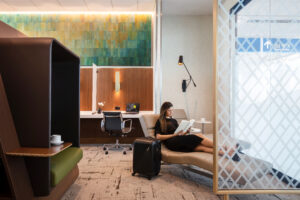


Quiet calm spaces, with a ‘home from home’ experience
Knowing your customer audience and understanding their needs is integral to the foundations of terminal design, agrees DiFurio. “Since the pandemic we have noticed a reduction in business travel and the recovery has been much more driven by leisure traffic and families,” she says. “It’s still important to offer quiet, calm spaces where passengers can continue working if they want to, but the growth in leisure traffic is driving demand for more of a ‘home away from home’ experience.
“Passengers want a cosy, warm, inviting atmosphere. Within reason, it’s about creating more of the ambience you find in an airport lounge, reflecting a sense of place and incorporating outdoor spaces or biophilic design within the terminal.”
Living walls
Whether it’s water features, natural materials or living walls, the incorporation of biophilic design is another growing trend.
According to Biotecture, which has collaborated with several airports including Muscat to install living walls, these features can breathe life into previously sterile spaces and create a calm, attractive and relaxing environment for passengers.
Richard Sabin, Biotecture’s Managing Director, says: “Living walls provide the opportunity to put large quantities of toxin-reducing plants into terminal buildings without taking up any valuable floor space. They also help to improve air quality within the airport terminal, with travellers and staff alike enjoying the health and wellbeing benefits we get from being close to nature.”
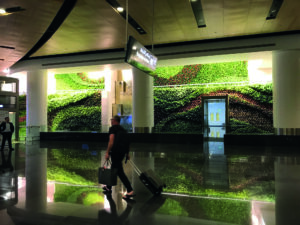


Plant life: Biotecture breaths life into Muscat Airport with its living wall featuring 24,000 plants.
Sabin notes that the living walls situated within Muscat’s arrival and departures area feature 13 different plant species and include a total of 24,000 plants.
“They make a huge statement about the airport’s commitment to clean air, health and wellbeing, whilst creating a positive customer experience that will keep passengers coming back, time and time again.”
A recent survey commissioned by Biotecture found that 78% of those questioned say greenery improves their mental wellbeing.
Sabin adds: “There is substantial evidence demonstrating the ability of plants to remove volatile organic compounds from the air. In fact, plants can cut CO2 levels in indoor spaces by a quarter.”
Living walls also have a hidden benefit in that they reduce noise within their environment by absorbing, diffracting and reflecting sound. Reducing noise and improving acoustics has been found to lead to lower stress levels.
It’s not just passengers that benefit. “Studies have shown that when people can see greenery whilst they work, their creativity, productivity and concentration levels all increase,” says Sabin. “Greenery, ventilation and natural light are often cited as important factors for greater workplace satisfaction.”
For cash-strapped air transport hubs thinking that an investment in plant life is perhaps a step too far, Sabin notes that there are a variety of living wall systems to suit most project budgets.
“We have a solution for every type of terminal,” he says. “Our patented modular hydroponic BioPanel system combines efficient water management with remote sensing technology, while our freestanding PlantBox system is stackable and facilitates vertical greening in smaller commercial locations.”
Light and bright
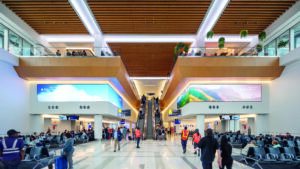


Stress free: Corgan’s designs at LaGuardia (above) and DFW (right) help keep passengers calm and relaxed.
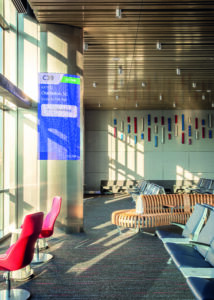

Much like the incorporation of biophilic design and its ability to reduce stress, lighting, acoustics and textures all have an impact on a passenger’s experience and wellbeing.
Corgan’s DiFurio cites a recent project her company collaborated on – the High C Gates at Dallas Fort Worth (DFW) in the US.
Explaining that DFW is a classic example of a terminal building built in the 1970s or 1980s, which presents its own challenges when dealing with the customer expectations of today, she notes how the new gate area is now more energy efficient, incorporating plenty of natural light with windows that tint in the sun and natural materials.
“Your whole mood changes when you enter this space,” she says. “Passengers feel calm and more relaxed within this environment.”
Similarly, at LaGuardia, Corgan recently completed work on a $4.7 billion terminal for Delta, which now features plenty of light, bright space thanks to expansive window panels, wide walkways and commissioned murals and sculptures in partnership with the Queens Museum. The whole look and feel reflects a new kind of airport experience.
Putting passengers first
There is no shortage of factors at play when it comes to balancing wellbeing with the functionality of air travel.
Wayfinding and signage to help passengers get their bearings, as well as digital displays and interactive maps are all being integrated into terminal design to minimise the stress associated with getting lost or missing a flight.
Elsewhere, hygiene and the desire for a touchless journey is driving innovation with self-service solutions, doors activated by sensors and biometric technology.
Adequate ventilation, air filtration systems and antimicrobial materials are also increasingly being used, while on a more simple level DiFurio says hand sanitiser stations should always be available throughout the terminal – as much to reassure passengers as to keep hands clean.
The incorporation of all these elements is undeniably transforming airport design. By prioritising comfort, relaxation and convenience to provide a more human-centric travel experience, terminals are prioritising the passenger and the wellbeing of all those who travel through them.
This article was initially published in the June 2023 edition of Regional Gateway. If you aren’t already a subscriber to Regional Gateway, you can subscribe here.
If you enjoyed reading this article, you might like these news pieces:
